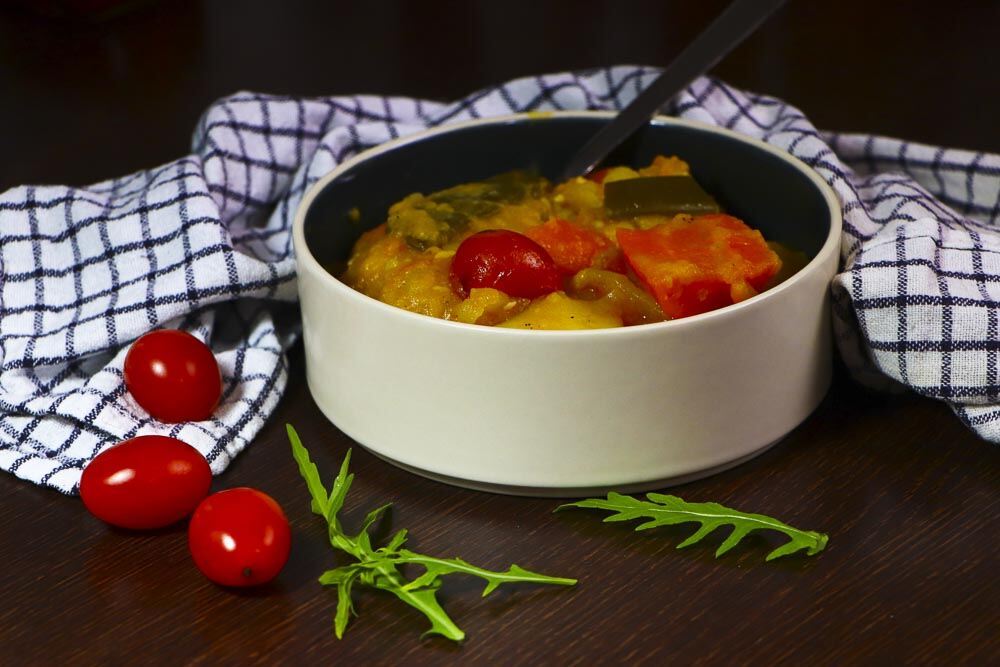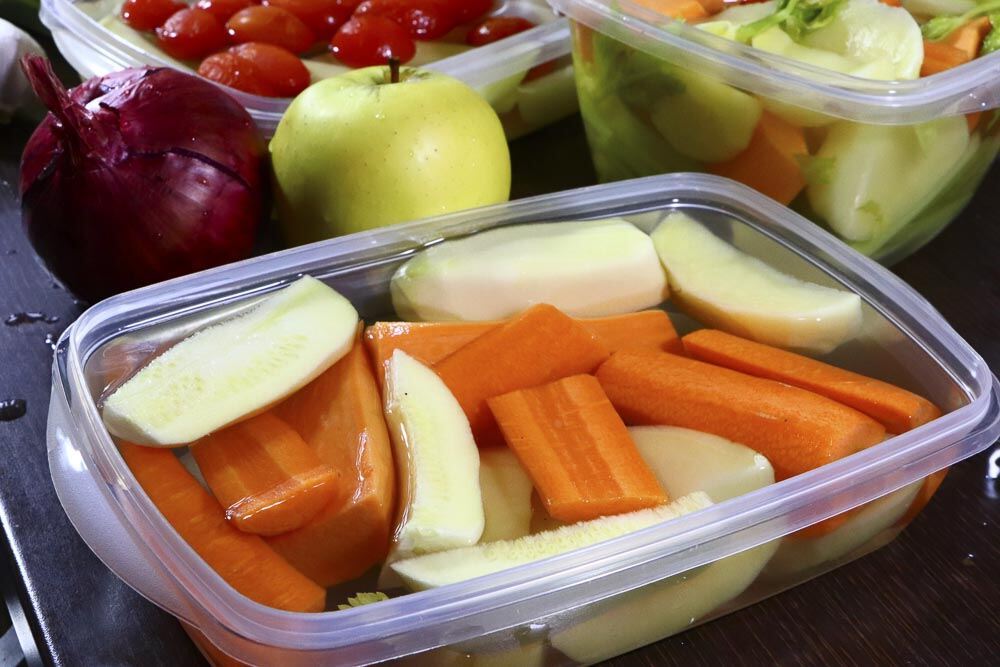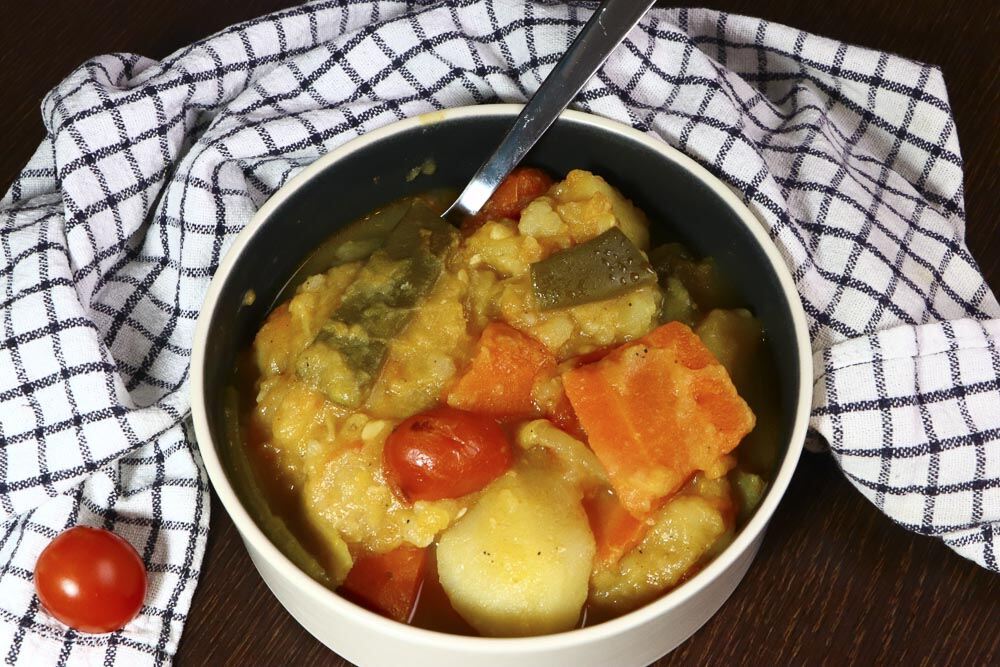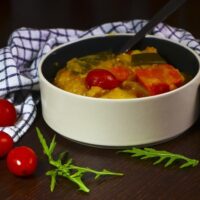Comfort in a Bowl: The Perfect Vegan Stew for Any Season
Thank you for reading this post, don't forget to subscribe!When the weather turns chilly, there’s nothing quite like a hearty bowl of vegan stew to warm you from the inside out. This recipe brings together a delightful medley of vegetables, each contributing its unique flavor and texture, for a comforting dish that’s both nourishing and satisfying.

Vegan Stew Notes about the Ingredients
- Potatoes & Sweet Potato: These root vegetables add heartiness and a creamy texture to the stew. They also absorb flavors beautifully, making them perfect for stews.
- Green Beans: Offer a nice snap and a fresh contrast to the softer vegetables.
- Cherry Tomatoes: Burst in the heat of the stew, adding a sweet and tangy flavor that enriches the overall dish.
- Carrots: Bring a touch of sweetness and lots of vitamins.
- Red Onion & Garlic: Form the flavor foundation with their aromatic qualities.
- Green Apple: Adds a unique, subtle tartness and thickens the stew as it cooks down.
- Olive Oil: Used for sautéing, it introduces a rich, fruity base note.
- Seasonings: Salt, paprika, and black pepper provide simple but essential seasoning that enhances the natural flavors of the vegetables.
- Vegetable Broth: Acts as the stewing liquid, infusing the vegetables with more flavor as they cook.

Tips for Making the Best Vegan Stew
- Start with a Sauté: Begin by sautéing onions and garlic in olive oil until they are translucent. This method releases their aromas and sets the stage for a flavorful stew.
- Layer the Flavors: Add the spices early in the cooking process to allow them to develop depth as the stew cooks.
- Cut Vegetables Evenly: Ensure that all vegetables are cut into similar sizes to promote even cooking.
- Simmer Gently: Allow the stew to simmer gently to prevent the vegetables from breaking apart and to meld the flavors together.
- Adjust Consistency: Depending on your preference for a thicker or more broth-like stew, adjust the amount of broth and consider mashing some of the potatoes into the stew to thicken it naturally.

Vegan Stew Serving Suggestions
- With Fresh Bread: Pair this stew with a loaf of warm, crusty bread. It’s perfect for sopping up the flavorful broth, adding a satisfying crunch and a fulfilling touch to your meal.
- Over Grains: Serve the stew over a bed of cooked grains like quinoa, brown rice, or barley. This not only stretches the meal further but also adds a wonderful texture contrast and packs in additional fiber and protein.
- With a Dollop of Vegan Cream: For an extra creamy texture, top each serving with a dollop of vegan sour cream or a swirl of coconut cream. This addition enriches the dish, giving it a luxurious finish that beautifully complements the stew’s earthy flavors.
- Garnished with Fresh Herbs: Sprinkle chopped fresh parsley, cilantro, or dill over the stew just before serving. Fresh herbs will add a burst of color and a fresh, aromatic kick that lifts the overall flavor profile.
- Accompanied by a Green Salad: Serve the stew with a crisp green salad dressed lightly with a lemon vinaigrette. The freshness and crunch of the salad offer a delightful contrast to the richness of the stew, making for a balanced meal.
- With Roasted Vegetables: Offer a side of roasted vegetables, such as Brussels sprouts, broccoli, or cauliflower. The char and crisp from roasting these vegetables introduce an additional layer of flavor and texture to the meal.
Recipe Variations of Vegan Stew
- Spicy Kick: For those who enjoy a bit of heat, adding a teaspoon or two of chili flakes, a dash of cayenne pepper, or even some freshly chopped jalapeños can bring a warming spice to the stew. This version is particularly comforting in the colder months.
- Mediterranean Flavors: Incorporate elements like olives, capers, and a splash of lemon juice towards the end of cooking to imbue the stew with Mediterranean flair. Herbs like rosemary and thyme also complement this variation wonderfully.
- Asian Twist: Add coconut milk for creaminess, along with curry paste or powdered spices such as turmeric, cumin, and coriander to give your stew an Asian-inspired flavor. A few drops of soy sauce or tamari can deepen the umami profile of the dish.
- Hearty Protein Boost: Include plant-based proteins like chickpeas, lentils, or cubed tofu to make the stew even more filling. These additions contribute not only extra texture and substance but also significant nutritional value.
- Root Vegetable Medley: Swap out some of the regular potatoes or sweet potatoes with other root vegetables like parsnips, turnips, or rutabagas. Each brings its unique sweetness and texture, enhancing the complexity of the stew.
- Autumn Harvest: In the fall, add squash or pumpkin to the mix. These seasonal vegetables make the stew naturally sweeter and are perfect for creating a comforting autumnal dish.
- Greens Galore: Towards the end of the cooking process, stir in some kale, spinach, or Swiss chard. These greens will slightly wilt in the hot stew, adding color, texture, and a host of vitamins and minerals.
- Moroccan Influence: For a Moroccan-style stew, include spices like cinnamon, ginger, and allspice. Serve with a side of couscous to complement the rich flavors of the stew.

Frequently Asked Questions About Vegan Stew
- What makes a stew “vegan”? – A vegan stew excludes all animal products, including meats, dairy, and animal-derived broths. Instead, it focuses on vegetables, legumes, and plant-based proteins, using vegetable broth or water as the base. Spices and herbs add flavor without the need for non-vegan additives.
- Can I make this stew in a slow cooker? – Absolutely! Vegan stew is ideal for slow cooking. Simply add all ingredients to your slow cooker and set it on low for 6-8 hours or on high for 3-4 hours. This method allows the flavors to meld beautifully and the vegetables to become tender, enhancing the overall taste and texture.
- How can I thicken my vegan stew? – To thicken the broth, you can use a few methods:
- Cornstarch or Arrowroot: Mix a tablespoon with a little cold water and stir it into the stew, then allow it to simmer for a few more minutes.
- Blended Vegetables: Take a cup of the stew’s vegetables, blend them smooth, and stir them back into the pot.
- Lentils or Beans: Adding pureed beans or lentils not only thickens the stew but also boosts its protein content.
- Is vegan stew gluten-free? – Vegan stew is naturally gluten-free if you ensure that all the ingredients, including spices and broths, are free of gluten. Always check labels if you’re using store-bought ingredients to make sure they don’t contain gluten or were processed in a facility that handles gluten-containing products.
- What are the best vegetables to use in vegan stew? – Root vegetables like potatoes, carrots, and sweet potatoes are excellent because they hold up well during cooking. You can also use squash, mushrooms, bell peppers, and zucchini. For added texture and nutrition, include green vegetables like spinach or kale towards the end of cooking.
- How long can I store vegan stew? – Vegan stew can be stored in the refrigerator for up to 4-5 days. Make sure it’s cooled to room temperature before refrigerating in an airtight container. It can also be frozen for up to 3 months. Thaw in the refrigerator overnight and reheat gently on the stove or in the microwave.
- Can I add grains to vegan stew? – Absolutely! Grains like barley, quinoa, or farro can be added to vegan stew to create a heartier dish. If you choose to add grains, remember they will absorb some of the liquid, so you may need to adjust the amount of broth accordingly.
- What can I do to add more flavor to vegan stew? – Herbs and spices are your best friends in vegan cooking. Consider sautéing onions and garlic before adding them to the stew as they provide a flavor base. Smoked paprika, cumin, coriander, and bay leaves also add depth. Don’t forget a splash of soy sauce or balsamic vinegar at the end for a little acidity and umami.
Vegan Stew Equipment Needed
- Large pot or Dutch oven
- Chef’s knife and cutting board
- Wooden spoon or spatula
- Measuring spoons
This vegan stew is a testament to how simple ingredients can come together to create a dish that’s full of flavor and goodness. It’s perfect for meal prep, as it stores and reheats well, and it’s versatile enough to accommodate any personal tweaks. Whether you’re a long-time vegan or just looking for a satisfying, meat-free meal, this stew is sure to please.
More Lunch Ideas:

Vegan Stew
This vegan stew is a hearty, nourishing meal perfect for colder weather or any time you need a comforting dish. The combination of root vegetables with a hint of sweetness from the apple and a robust seasoning makes it a satisfying meal that's also packed with nutrients.
Ingredients
- 3 potatoes, peeled and cubed
- 1 sweet potato, peeled and cubed
- 1 cup green beans, trimmed and halved
- 1 cup cherry tomatoes
- 1 zucchini, peeled and cubed
- 2 carrots, peeled and sliced
- 1 red onion, chopped
- 4 cloves of garlic, minced
- 1 green apple, cored and diced
- 1 cup celery
- 3 tablespoons olive oil
- 1 teaspoon salt
- 1 teaspoon paprika
- 1/2 teaspoon black pepper
- 4 cups vegetable broth
Instructions
- Begin by preparing all your vegetables. Wash, peel, and chop the potatoes, sweet potato, carrots, and green apple as described. Clean and halve the green beans, and halve the cherry tomatoes. Peel and finely chop the red onion and garlic.
- In a large pot, heat the olive oil over medium heat. Add the chopped red onion and garlic and sauté for about 2-3 minutes, or until the onion becomes translucent and fragrant.
- Add the cubed potatoes, celery, sweet potato, and carrots to the pot. Stir well to coat them with the oil and sautéed onions. Cook for about 5 minutes, stirring occasionally.
- Sprinkle the salt, paprika, and black pepper over the vegetables. Mix well to ensure all the pieces are evenly coated with the spices.
- Add the green beans, cherry tomatoes, zucchini and green apple to the pot. Stir everything together to distribute the spices and aromatics evenly.
- Pour the vegetable broth into the pot. Bring the mixture to a boil, then reduce the heat to a simmer.
- Let the stew simmer uncovered for about 25-30 minutes, or until all the vegetables are tender and the flavors have melded together.
- Taste and adjust seasoning if necessary. If the stew is too thick, add a little more broth or water to reach your desired consistency.
- Serve the vegan stew hot. This dish can be garnished with fresh herbs such as parsley or basil for an added touch of freshness and color.
Notes
- Fresh vegetables are the cornerstone of any great stew. Choose firm, brightly colored vegetables without any spots or blemishes. Fresh herbs, if available, can also elevate the flavor significantly compared to dried ones. Fresh ingredients ensure the stew has vibrant colors and flavors.
- Taste your stew towards the end of cooking and adjust the seasonings as needed. Sometimes a little extra pinch of salt, a dash of pepper, or a splash of vinegar can balance the flavors perfectly. Don't be afraid to personalize the seasoning to match your taste preferences.